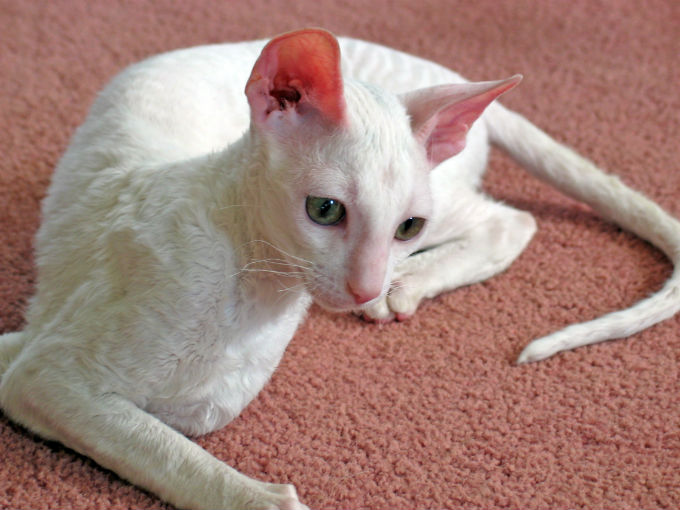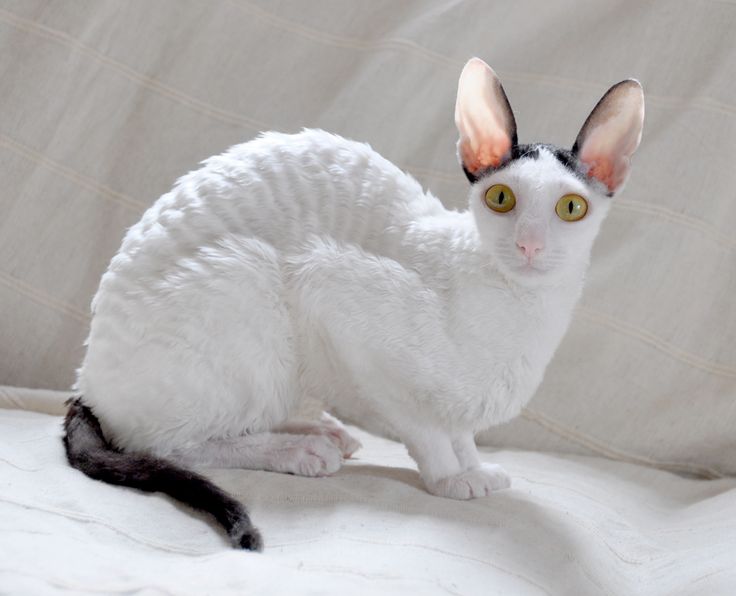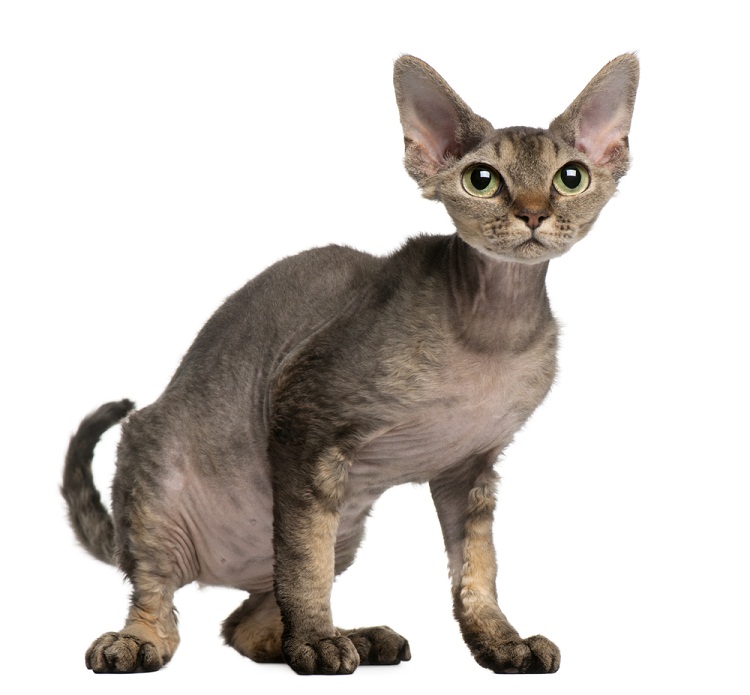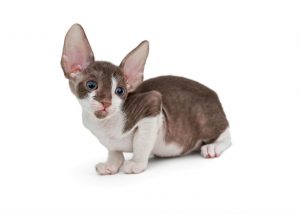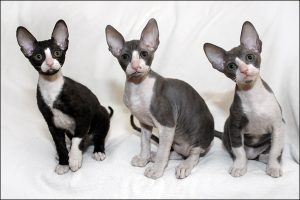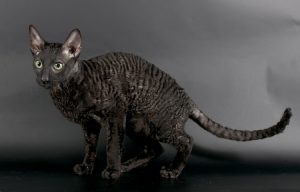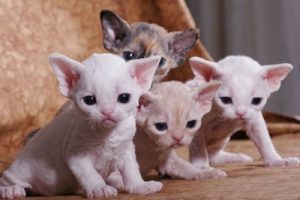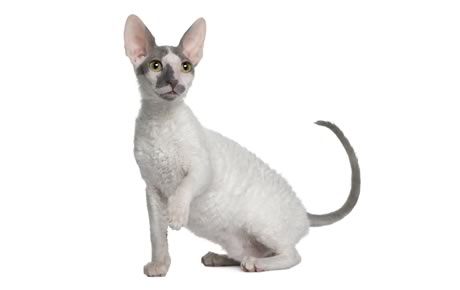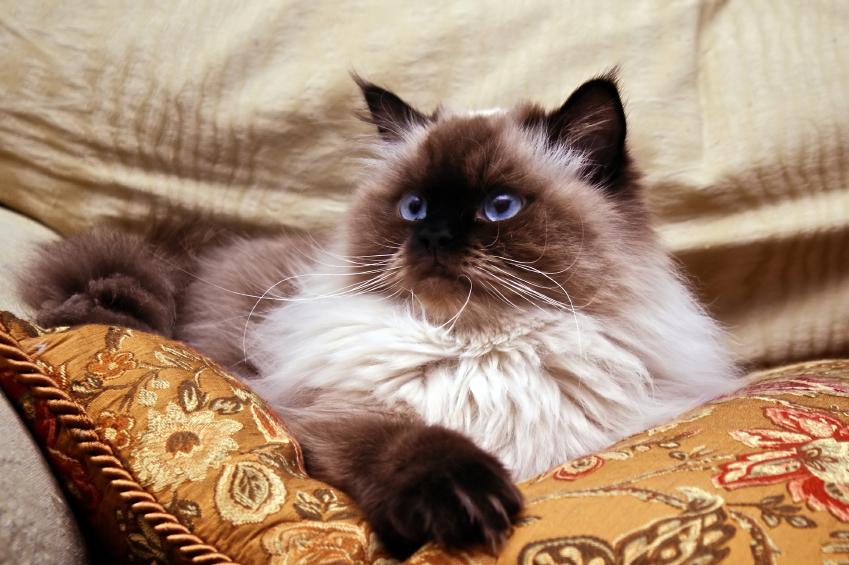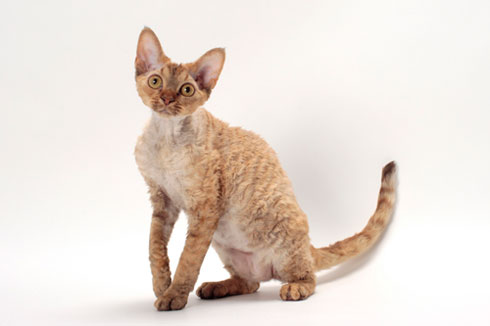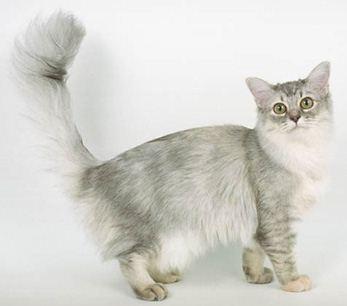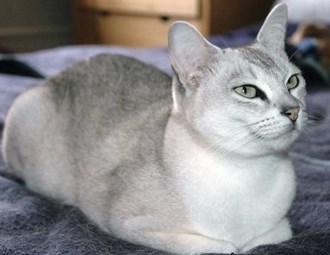What is a Cornish Rex
The Cornish Rex is a domestic hairless cat with a striking wavy, curly coat that is an outcome of natural mutation. Referred to as the Greyhound due to its long and lean stature, these elegant looking cats are just reverse of their personality, with energy, affection, and intelligence being their dominant traits, also making them an owner’s delight.
Quick Information
Physical Appearance & Size
| Body Type: | Medium |
| Physical Appearance: | Sleek and slender built; egg-shaped head; big-sized ears; large, oval eyes that slightly slant upwards; round forehead; high cheekbones; Roman nose (having a high bridge); deep chest; arched back; belly curving upwards resulting in a small waistline; muscular thighs and hips; dainty, slender legs; oval paws; long tail tapering at the end. |
| Weight ( Size): | Male: 7 to 10 pounds; Female: 5 to 7 pounds |
Colors & Patterns
| Coat type | Short, soft, wavy, curly, silky |
| Color: | White, chocolate, black, orange, cream, blue, lilac, silver, lavender |
| Eye color: | Gold, hazel, green or even odd-eyed |
| Pattern: | Rex (soft curled fur), tabby, bi-color, tortoise shell |
Other Characteristics
| Lifespan/How long do they live: | 11 to 15 years |
| Behavioral Characteristics: | Intelligent, active, curious, friendly, enthusiastic, sociable |
| Lap Cat: | Yes |
| Shedding ( Do they shed): | Minimal |
| Vocalization: | Low (quiet, but can express itself when needed) |
| Good with Children: | Yes |
| Are they hypoallergenic: | Yes |
| Country: | United Kingdom |
| Competitive Registration/ Qualification: | CFA, TICA, FIFe, ACF, AACE, ACFA/CAA,CCA-AFC, GCCF |
History
The history of these unique cats started in Bodmin Moor, farmland in Cornwall, in the United Kingdom. In the year 1950, Serena, a tortoise shell cat, belonging to Mrs. Nina Ennismore produced five kittens of which one with a red and white coloration possessed a curly coat that differed from the rest. Named as Kallibunker or Kalli by its owner, she bred it back to its mother as suggested by geneticist AC Jude. The outcome was three kittens, a female with straight coats and two males with curly coats. Though one of the males died early when it was just seven months old, the second one, as well as Kallibunker, fathered other litters.
Mrs. Ennismore continued outcrossing to create the short coat and among the several cats which she crossed Poldhu along with his daughter LaMorna Cove, contributed to the future development of the Cornish Rex. She (LaMorna Cove) was imported to the United States, being instrumental in establishing this bred there.
Since it had an extremely small in the 50s and 60s, it was declared as endangered. Outcrossing the Cornish Rex started with other domestic breeds such as the British Shorthair, American Shorthair, Russian Blue, Siamese and Havana Brown to strengthen its foundation. The outcrosses also helped in enhancing its colors as well as patterns. Obtaining registrations by the ACFA (American Cat Fanciers Association) and CCA (Canadian Cat Association) in 1963, and the CFA ( Cat Fanciers Association) in 1964.
Temperament and Personality
- Highly sociable cat, loving to involve themselves in every matter of their household, also seeking attention.
- Has an affectionate nature, enjoying a pat or cuddle on its caregiver’s lap.
- Does not mind when held, which therefore makes it a great therapy cat.
- Being a family cat, they detest when left alone for prolonged periods.
- Though quiet, they can reciprocate to love and care by patting on their family member’s cheeks, throwing a kiss or even flipping their tail.
- Has a vocalization that can be soft and soothing or loud and harsh, heard only when it desires to voice its opinion.
- Possesses a dog-like trait in retrieving, fetching or throwing toys with the help of their paws, used by them as hands.
- Can deal with objects efficiently, with its long toes helping it to open cabinets or doors quickly.
- Having an immense liking for food, it will not think twice about getting onto the kitchen cellar and stealing its favorite cookie.
- Acrobatic and flexible, climbing to the top most place in its house, and surveying everything from there.
- Gets along well with children, emerging as their perfect playmate.
- Shares a good rapport with other cats and cat-friendly dogs.
- Prefer staying in warm places as their body temperature is a little higher than other cats.
- Has a pleasant disposition towards guests and interacts with them in a friendly way.
- Easily adaptable, adjusting to any environment it is put in.
Who is the Cornish rex good for
- Homes seeking for an affectionate, companion pet, which can also amuse them with its clownish feats.
- People, desiring for a cat with dog-like traits.
- Houses where someone of the other is always present to give them company.
- Owners, wishing for a cat to entertain them with its cool tricks.
- Families that travel too often and need to carry their cats with them.
- Households having ailing people or even seniors who are living alone.
Devon Rex vs. Cornish Rex
| Devon Rex | Cornish Rex |
| Has guard hair | Does not have guard hair |
| Short, square head | Oval-shaped head narrow at the nose |
| Low set ears | High set ears |
| Lean with an arched back | Heavy bodied with a muscular built |
Care
Because of its soft, silky coat, without guard hairs, the Cornish Rex needs minimum grooming. You can start grooming manually, by running your wet hands through its whole body (head to tail) gently. This also an excellent way to check out for allergies or rashes. However, those with long and wooly coats would need weekly brushing with a soft bristle brush or even a comb having fine-tooth. Bathe your cat using a shampoo of high quality only when it gets dirty. Other hygiene requirements include brushing its teeth on a regular basis, cleaning its eyes using a soft, moist cloth for removing discharge as well as wiping its ears with a solution of water and vinegar whenever they get dirty. During the cold months, a sweater would help to keep them warm.
- Hypertrophic cardiomyopathy where the affected cats encounter a heart murmur ( swishing sound during heart beat).
- Patellar luxation.
- Eye problems like congenital hypotrichosis (hereditary blindness)
- Sunburn ( because of its hairless coat)
Training
These cats can be taught interesting tricks because of their sharp brains. If you have a beautiful little piano in your hall, teach your kitty to play it. The Cornish Rex, with its longish body stature, would not have much difficulty in learning this skill. First, allow it to get used to the piano by keeping it on your lap when you play it. It may by chance touch one or two keys with its paws while sitting with you. If it does not gain interest, then keep its favorite toy or even a treat near the instrument so that the urge of getting it makes it hit the keys.
What does a Cornish Rex eat
Besides a good quality cat food, balance its diet with protein, vitamins, and minerals. The Cornish Rex has little control over its feeding habits and may grab a bowl full of its favorite food within minutes after a meal. Therefore, owners need to be cautious about their food habits to avoid any hassles in future.

